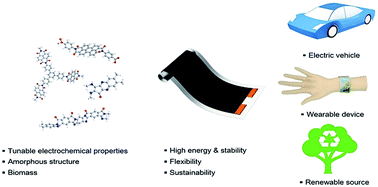Organic small molecules and polymers as an electrode material for rechargeable lithium ion batteries
Abstract
Organic electrode materials are promising for electrochemical energy storage devices because they have a high theoretical capacity, structural diversity, and flexibility. In addition, they are light weight, inexpensive, and environmentally benign. Organic electrode materials are a promising alternative to conventional inorganic materials. Various organic materials, such as conducting polymers, organodisulfides, nitroxyl radical polymers, and conjugated carbonyl compounds, have been studied as electrode materials for lithium batteries. Among them, small organic carbonyl compounds and polymers containing carbonyls have been widely studied as electrode materials because of their high theoretical capacity, fast redox kinetics, and structural diversity. However, these materials have intrinsic drawbacks, such as solubility in electrolyte media and a low conductivity. Herein, methods to solve these problems by increasing the polarity are discussed. The polarity of small molecules could be increased by forming salts. In addition, the conductivity could be enhanced using a chemical doping strategy or forming a composite with a conductive additive. This review provides guidance for the design of a new type of organic material for next-generation rechargeable batteries.



 Please wait while we load your content...
Please wait while we load your content...